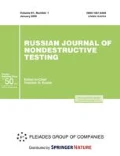Abstract
An automated defect recognition algorithm is presented for detecting and classifying weld defects by photographic images. The proposed recognition algorithm selects a defective domain in a segmented image, extracts geometric features from the image, and relates the defect to one of six classes: no defect, cavity, longitudinal crack, transverse crack, burn-through, or multiple defect. The algorithm is implemented in the Matlab 2018b MathWorks environment and has been tested on 60 photographs of defects of various classes; the accuracy of recognition was 85%.





Similar content being viewed by others
REFERENCES
Akbolatov, E.Z., Kiselev, A.S., and Slobodyan, M.S., Prediction and stabilization of initial resistance between electrodes for small-scale resistance spot welding, Weld. World, 2019, vol. 63, no. 2, pp. 443–457.
Muravyov, S.V., Borikov, V.N., and Natalinova, N.M., A computer system: Measurement of welding surge currents, Meas. Control, 2009, vol. 42, no. 2, pp. 44–47.
ISO 17637:2016. Non-destructive testing of welds—Visual testing of fusion-welded joints.
GOST (State Standard) R ISO 17637—2014. Non-destructive testing. Visual inspection of joints made by fusion welding.
ISO 6520-1:2007. Welding and allied process—Classification of geometric imperfections in metallic materials—Part 1: Fusion welding.
GOST (State Standard) R ISO 6520-1-2012. Welding and related processes. Classification of defects in geometry and continuity in metallic materials. Part 1. Fusion welding.
Wang, Y., Sun, Y., Lv, P., and Wang, H., Detection of line weld defects based on multiple thresholds and support vector machine, NDT&E Int., 2008, vol. 41, no. 7, pp. 517–524.
Kumar, G.S., Natarajan, U., Veerarajan, T., and Ananthan, S.S., Quality level assessment for imperfections in GMAW, Weld. J., 2014., vol. 93, no. 3, pp. 85–97.
Valavanis, I. and Kosmopoulos, D., Multiclass defect detection and classification in weld radiographic images using geometric and texture features, Expert Syst. Appl., 2010, vol. 37, no. 12, pp. 7606–7614.
Gadelmawla, E.S. and Elewa, I.M., On-line measurement of product dimensions using computer vision, in Proc. 9th IMEKO TC14 Symp. (ISMQC, September 24–27,2001, Cairo, Egypt), pp. 24–27.
Epifantsev, B.N. and Zhumazhanova, S.S., On the effect of the shape of a flaw on its detectability against noise background, Russ. J. Nondestr. Test., 2017, vol. 53, no. 1, pp. 62–70.
Wang, G. and Liao, T.W., Automatic identification of different types of welding defects in radiographic images, NDT&E Int., 2002, vol. 35, no. 8, pp. 519–528.
Boaretto, N. and Centeno, T.M., Automated detection of welding defects in pipelines from radiographic images DWDI, NDT&E Int., 2017, vol. 86, pp. 7–13.
Zou, Y., Du, D., Chang, B., Ji, L., and Pan, J., Automatic weld defect detection method based on Kalman filtering for real-time radiographic inspection of spiral pipe, NDT&E Int., 2015, vol. 72, pp. 1–9.
Zahran, O., Kasban, H., El-Kordy, M., and El-Samie, F.A., Automatic weld defect identification from radiographic images, NDT&E Int., 2013, vol. 57, pp. 26–35.
Barkhatov, V.A., Recognizing imperfections with an artificial neural network of a special type, Russ. J. Nondestr. Test., 2006, vol. 42, no. 2, pp. 92–100.
Hou, W., Wei, Y., Guo, J., Jin, Y., and Zhu, C.A., Automatic detection of welding defects using deep neural network, J. Phys.: Conf. Ser.,IOP Publ., 2018, vol. 933, no. 1, p. 012006.
Sikora, R., Baniukiewicz, P., Chady, T., Lopato, P., and Psuj, G., Artificial neural networks and fuzzy logic in nondestructive evaluation, in Proc. 18th World Conf. Nondestr. Test. (April 16–20,2012, Durban. South Africa), pp. 1–11.
Mery, D. and Berti, M.A., Automatic detection of welding defects using texture features, Insight (Northampton, U.K.), 2003, vol. 45, no. 10, pp. 676–681.
Binarization by brightness threshold cutoff. http://matlab.exponenta.ru/imageprocess/book3/6/im2bw.php. Accessed January 23, 2019.
Muravyov, S.V., Khudonogova, L.I., and Emelyanova, E.Y., Interval data fusion with preference aggregation, Measurement, 2018, vol. 116, pp. 621–630.
Funding
This work was supported by the Russian Science Foundation, project no. 18-19-00203.
Author information
Authors and Affiliations
Corresponding authors
Additional information
Translated by V. Potapchouck
Rights and permissions
About this article
Cite this article
Muravyov, S.V., Pogadaeva, E.Y. Computer-Aided Recognition of Defects in Welded Joints during Visual Inspections Based on Geometric Attributes. Russ J Nondestruct Test 56, 259–267 (2020). https://doi.org/10.1134/S1061830920030055
Received:
Revised:
Accepted:
Published:
Issue Date:
DOI: https://doi.org/10.1134/S1061830920030055




